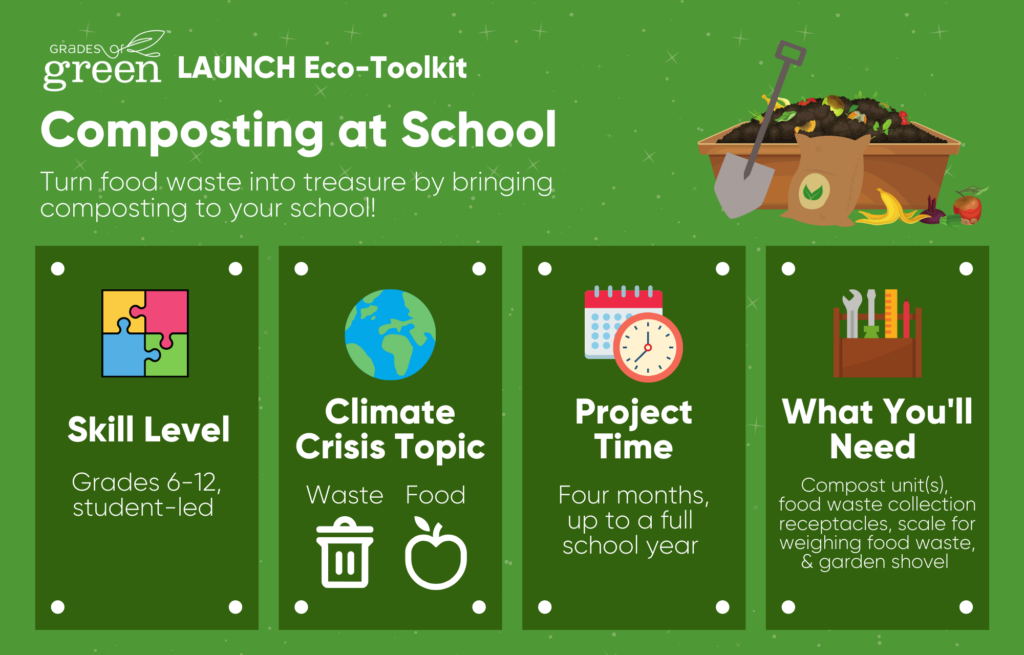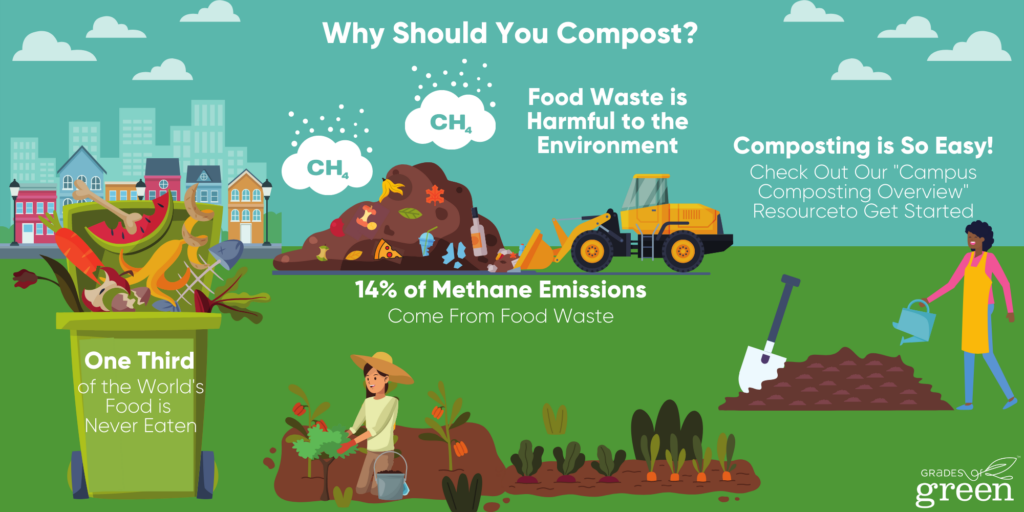Who wants to make magic with food scraps?!
In this fun project toolkit, you’ll be doing a little bit of magic! You’ll be turning something no one wants – food scraps and uneaten eats – into something worth its weight in gold: incredible, nutrient-rich soil that’s perfect for growing healthy, tasty and wonderful food. We’ll provide you with everything you need to set up a successful composting program at your school.

Toolkit Details


NGSS
This toolkit address the following Science and Engineering Practices (SEPs) within the Performance Expectations of NGSS for Grades: 6-8 and 9-12
- Asking Questions and Defining a Problem
- Planning and Carrying out Investigations
- Analyzing and Interpreting Data
- Using Mathematics and Computational Thinking
- Constructing Explanations and Designing Solutions
- Obtaining Evaluating, and Communicating Information
Learning Objectives
- Analysis
- Students will analyze their classroom/school for an ideal location to compost
- Project Management
- Students will organize the necessary materials to operate a composting station
- Students will manage composting receptacles to ensure the process is happening smoothly
- Students will exercise effective communication and accountability.
- Evaluation and Assessment
- Students will track and evaluate the information they have collected
What is Composting?
Composting is nature’s way of recycling. Similar to nature when deceased plants and animals decompose into the soil, we too can turn decomposing food waste into a nutrient rich product called humus that can regenerate the Earth’s soil.
What You Will Accomplish
Composting is good for your school and the planet! By composting your school’s food waste, you will:
- Reduce the waste going into a landfill
- Cut down on harmful greenhouse gas emissions
- Turn that food waste into humus or compost
- Regenerate the soil on your campus and in your community
- Be able to grow food in your rich soil
Why Should You Compost?
The resources provided can be shown as a slideshow or printed out as individual worksheets for students to learn.

Billions of Pounds of the Food We Produce is Wasted
Did you know more than 60 billion pounds of mineral-rich food go to landfills each year in the U.S. alone [1] while US schools waste 530,000 tons of food annually.[2] That’s right, sadly, about 70% of the waste that we throw away without a second thought could be repurposed to create a nutrient rich product that supports healthy soil and can grow nutritious food without using chemical fertilizers. [3]
Wasted Food is Harmful to the Environment
When food waste rots in a landfill it releases harmful greenhouse gasses that trap the sun’s heat in our atmosphere and contribute to global warming. According to the US Environmental Protection Agency, food is the single largest category of waste put in landfills. Food in landfills emits methane, a powerful greenhouse gas. Landfills are the third-largest source of human-related methane emissions in the United States. [4]
However, when food is composted, it releases no greenhouse gasses at all, effectively reducing emissions mentioned above.
Composting Is So Easy!
Composting is nature’s way of recycling. It happens every second of every day when dead plants and animals decompose and break down into soil in natural environments. When food waste is combined with carbon rich materials like dried leaves, sawdust, shredded paper, moisture and heat from the sun, it will quickly break down and transform into humus, also known as compost. This can be done in a backyard compost bin, a community garden or sometimes through your municipal waste hauler. When added to gardens and landscaping, finished compost will help rebuild the soil nutrients and hold in moisture. Best of all – it’s the best soil to help you grow nutritious food!
Food Waste is an Environmental Justice Issue
Waste is often classified as an environmental justice issue due to the inequalities that exist between low and high-income communities. Wealthy neighborhoods are often given more resources to manage waste reductions while disenfranchised communities are frequently left with inefficient provisions to maintain a clean living environment. Furthermore, the same low-income communities are usually located in close proximity to waste management facilities where additional pollution burdens individuals. (Waste360)
The Compost Story by Kiss the Ground
Think About It!
Pre-Activity Questions
- Observe your lunchtime trash for a day. How much of it is made up of food waste?
- Where do you see food being wasted the most and why do you think it happens?
- What do you think happens to the food scraps your school throws away?
- Describe a time when you’ve seen natural things decompose or break down in nature.
- Why do you think composting is important?
Take Action: How to LAUNCH Composting at School
Follow the steps below to set up a successful composting system at your school! Need help? Contact us!
Step 1: Decide Who’s Participating
- 1-10 students – plan to collect and compost food waste once or twice a week
- Team – assign 1-2 people to collect food waste and manage compost daily
- School – assign a classroom or grade level to manage compost each week
Step 2: Meet Your School’s Decision Makers
Set up a meeting with your principal and custodial staff to obtain permission and discuss the best way to incorporate composting into the custodial staff’s current routine.
Step 3: Choose Where On Campus You’ll Compost
Composting activities will ideally take place in two locations on campus. Food scraps will be collected in the lunch area and taken to a separate location for composting. Take a look around your campus; ideal areas for composting are a school garden or out of the way area.
Step 4: Get What You Need to Succeed!
Obtain or purchase the correct compost units for your campus. Learn more by checking out the Types of Compost Systems info sheet.
- If you will be composting in a garden area or have access to a sunny, out of the way area with a dirt ground then a traditional bin composting unit is right for you.
- If you will be composting on concrete or have limited space then a tumbler is right for you.
- Make sure to have enough compost units for the amount of food waste you will want to compost (if you are adding food scraps daily, you may want to have 2-3 bins that you can rotate use between weekly, adding to one while the others rest).
- If your school has access to municipal composting services through your waste hauler then food scraps will go directly into your waste hauler compost cart to be picked up by your waste hauler.
Step 5: Teach Your Classmates About Compost
- You can use this handy script – our Student Composting Education Script – to teach your peers why composting is important, which food scraps can be composted and how to sort their food waste.
- Ideal ways to get your message to your school are by hosting a school assembly, giving classroom presentations, creating a video (and/or use the video link you watched earlier!) to be distributed to students or shown in class.
Step 6: Plan How You’ll Collect Food Waste
Develop a plan for collecting food waste and brown materials for onsite composting. (For municipal composting, food will be added directly to your waste hauler’s food waste cart and then be placed in the appropriate location to be picked up by your waste hauler for off site composting).
- Obtain or purchase buckets or cans that will be used only as a “food waste” receptacle.
- Print the signs provided to place on food waste receptacles to show students what can and can not be placed in the food scrap collection (this will differ for onsite and municipal composting).
- Announce to all students and faculty when food waste collection will begin.
- Brown materials like leaves and dried clippings will need to be added to the food waste at a 2:1 ratio. Make a plan to collect these from campus maintenance workers or school parents and store them in bags or a designated bin near the compost units on campus.
Have a Leaf Drive in the fall to build up a surplus of dried leaves for composting
- You can come up with a percentage based on the total waste you see.
- Have a scale? Weigh an empty bin that you will collect food waste in. Collect all the food waste and weigh it minus the weight of the bin.
Step 7: Plan How You’ll Manage Your Compost System
Develop a plan and schedule for transporting food scraps to the composter to be composted. Use our Campus Composting Team Organizer to organize your team. Ideally this will be done by a team of students who can take turns performing the following tasks:
- Review the Campus Composting Overview and “How To” doc (Pro Tip: print this document and post it near your composting supplies).
- Before lunch: place food waste receptacle with signage next to trash/recycle cans in the lunch area. Feel free to use our Compost Collection Receptacle Signs.
- After all students have eaten: Collect the food waste receptacles and take them to the compost area.
- Weigh food waste and record on our Composting at School Weekly Tracker .
- Empty the food waste into the compost bin and rinse the receptacle.
- Maintain your compost! Learn how to maintain your compost in bins and in tumblers below.
- Return tools and food waste receptacle to designated storage spots.
- At the end of the week, turn in the Composting at School Weekly Tracker form to your project manager.
- Turn the compost mixture with a shovel or spade to add oxygen.
- Add water if the mixture is too dry, compost should be about as moist as a wrung-out sponge. (pro tip: use the water from rinsing your food waste receptacle to add moisture to your compost bin).
- Add a thick layer of brown materials covering all of the visible food scraps to prevent flies.
- Close and secure lid of compost unit.
- Add twice as many brown materials as food scraps
- Add water only if the mixture is too dry, compost should be about as moist as a wrung-out sponge. Food scraps will normally provide all of the moisture needed in a tumbler.
- Close and secure unit door and rotate tumbler 3-4 times
Step 8: Compost Achieved!
Harvest compost when ready. Once a compost bin or tumbler is full it takes 3-4 months to break down into compost. Finished compost should look like dark, crumbly soil with few large pieces. It should smell like the forest. Shovel finished compost through half inch chicken wire or screen to filter out larger pieces (which can be put back into composter to finish breaking down). Store screened compost in a bin or tub then add it to landscaping or garden soil as needed.
Reflection Questions
How’d It Go?
- What did you enjoy most about composting your campus food waste?
- What were some roadblocks or difficulties you encountered?
- What surprised you the most about the compost process?
- How did you use the compost?
Report Your Student’s Impact
Congratulations!! You’ve implemented Composting at School! Don’t let all that hard work go unnoticed. Submit your results by clicking the green button below.
Project ongoing? No problem! Let us know what you’ve done so far.
By reporting your impact, Grades of Green can:
- CELEBRATE and elevate your students’ hard work and success.
- Offer our programs FREE for all students across the globe.
- AWARD stipends and certificates to hard-working educators and students.
Please take a few minutes to submit your results. Thank you!
Provided Resources
- Types of Compost Systems
- Student Composting Education Script
- Campus Composting Overview and “How To”
- Compost Collection Receptacle Signs
- Campus Composting Team Organizer
- Composting at School Weekly Tracker
- Composting at School Slides
- Toolkit Resources – Google Drive Folder
Congrats on completing our Composting at School Toolkit!
Did you enjoy this toolkit? Find your next project here!
